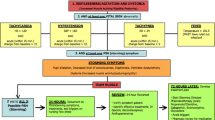Abstract
Introduction: Paroxysmal sympathetic storm (PSS) is a rare syndrome characterized by episodic hypertension, hyperhydrosis, hyperthermia, tachycardia, tachypnea, and extensor posturing.
Case reports: This article describes two cases of PSS: one following traumatic brain injury and the other following cardiac arrest.
Discussion: The first responded to labetalol, morphine, and codeine, whereas the second responded to labetalol.
Conclusion: These observations underscore the importance of central opioid receptors and nonselective β-adrenergic antagonists in modulating catecholamine pathways
Similar content being viewed by others
References
Penfield W. Diencephalic autonomic epilepsy. Arch Neurol Psychiatry 1929;22:358–374.
Penfield W, Jasper H. Epilepsy and the Functional Anatomy of the Human Brain. 1st. ed. Boston: Little Brown, 1954.
Bullard DE. Diencephalic seizures: responsiveness to bromocriptine and morphine. Ann Neurol 1987;21(6):609–611.
Darnell RB, Arbit E. Reversible diencephalic dysfunction: episodic hyperhidrosis due to a trapped third ventricle. Neurology 1993;43:579–682.
Bhigjee AI, Ames FR, Rutherford GS. Adult aqueduct stenosis and diencephalic epilepsy. A case report. J Neurol Sci 1985;71(1):77–89.
Boeve BF, Wijdicks EF, Benarroch EE, Schmidt KD. Paroxysmal sympathetic storms (“diencephalic seizures”) after severe diffuse axonal head injury. Mayo Clin Proc 1998;73(2):148–152.
Shapiro WR, Williams GH, Plum F. Spontaneous recurrent hypothermia accompanying agenesis of the corpus callosum. Brain 1969;92(2):423–436.
Do D, Sheen VL, Bromfield E. Treatment of paroxysmal sympathetic storm with labetalol. J Neurol Neurosurg Psychiatry 2000;69(6):832–833.
Solomon GE. Diencephalic autonomic epilepsy caused by a neoplasm. J Pediatr 1973;83(2):277–280.
Carmel PW. Vegetative dysfunctions of the hypothalamus. Acta Neurochir (Wien) 1985;75(1–4):113–121.
Ryan JB, Hicks M, Cropper JR, et al. Functional evidence of reversible ischemic injury immediately after the sympathetic storm associated with experimental brain death. J Heart Lung Transplant 2003;22(8):922–928.
Graham LN, Smith PA, Stoker JB, Mackintosh AF, Mary DA. Time course of sympathetic neural hyperactivity after uncomplicated acute myocardial infarction. Circulation 2002;106(7):793–797.
Author information
Authors and Affiliations
Corresponding author
Rights and permissions
About this article
Cite this article
Diamond, A.L., Callison, R.C., Shokri, J. et al. Paroxysmal sympathetic storm. Neurocrit Care 2, 288–291 (2005). https://doi.org/10.1385/NCC:2:3:288
Issue Date:
DOI: https://doi.org/10.1385/NCC:2:3:288




